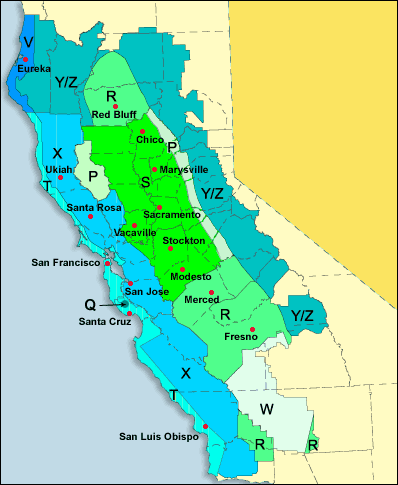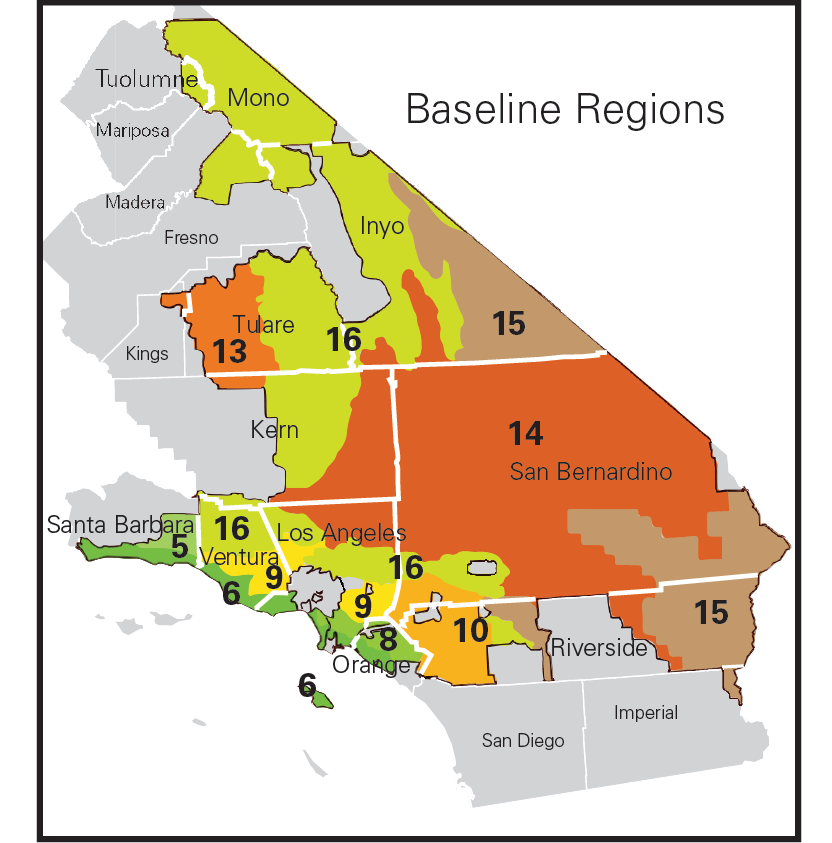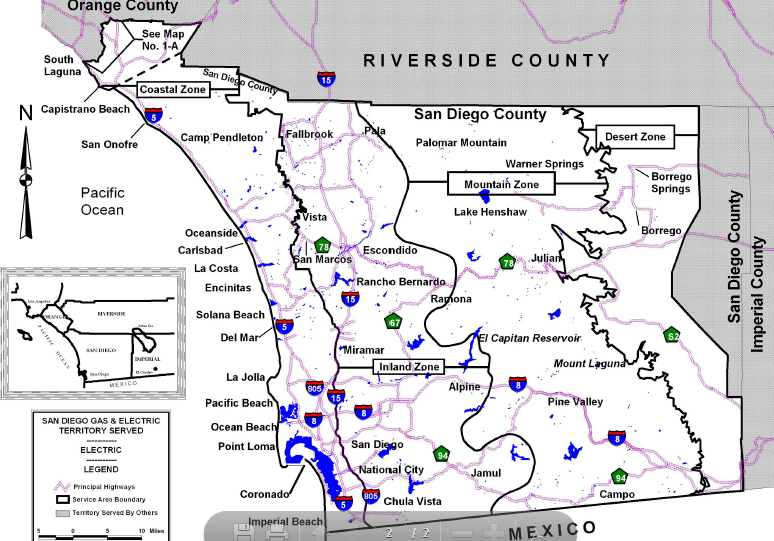Electric Rates
The CPUC must approve* all rates that each electric utility charges its customers. Once a utility's revenue requirement has been determined, a utility must propose what rate will be charged to customers in order to recover the revenue requirement. Rates are set in formal CPUC proceedings called ratemaking proceedings. The following types of regulatory proceedings address rates and rate design:
General Rate Case (GRC) Phase II proceedings review and approve the ways that costs are allocated to different customer classes and how those costs are collected from those classes. GRC Phase II proceedings follow GRC Phase I proceedings and occur on a three year cycle for the three large utilities.
Rate Design Window proceedings are shorter proceedings in between GRC Phase II cycles which address rate design issues.
Residential Rate Reform is a proceeding which began in 2012 to address the rate structure for residential customers and implement Assembly Bill 327 (Perea, 2013). In 2015, the Commission issued a decision (D.15-07-001) providing specific steps for the major investor owned utilities (IOUs) to reform the residential rate structure with an envisioned end-state of default time-of-use rates for residential customers in 2019.
Other Rate Proceedings
Special Tariffs
- Green Tariff/Shared Renewables Program (GTSR)
- Economic Development Rate (EDR)
- Net Energy Metering (NEM)
- Zero Emission Vehicle Programs
Reports and White Papers
- Actions to Limit Utility Costs and Rates - Annual Report to the Governor and Legislature
- 2025 Electric and Gas Costs Utility Reports
- 2024 Electric and Gas Costs Utility Reports
- 2023 Electric and Gas Costs Utility Reports
- 2022 Electric and Gas Costs Utility Reports
- 2021 Electric and Gas Costs Utility Reports
- 2020 Electric and Gas Costs Utility Reports
- 2019 Electric and Gas Costs Utility Reports
- 2018 Electric and Gas Costs Utility Reports
- 2017 Electric and Gas Costs Utility Reports
- 2016 Electric and Gas Costs Utility Reports
Rates Q&A
*Public Utilities Code section § 451 requires that the CPUC determine whether a utility's proposed rates, services, and charges are just and reasonable. *The investor-owned utilities periodically submit an Application to the CPUC requesting to collect a certain amount of revenue from its customers. This amount of revenue is intended to cover the utility’s costs plus a pre-approved rate of return, established in the Cost of Capital proceeding. The CPUC reviews this request and approves or modifies the amounts requested. This is the General Rate Case Phase 1 Process. Think of this as determining the size of the “pie” that the utility can have.
Next, the utility submits an Application to determine how much of the revenue (or “pie”) should be collected from different customers. For example, how much of the pie residential customers should pay for versus commercial or agricultural customers. This is determined by examining what and how much of each of the utility’s services are used by different types of customers. In most cases, all types of customers use all of the utility’s services, but some types of customers may use more or less of some services than others. This is part of the General Rate Case Phase 2 process. One can think of this as "slicing the pie."
Lastly, the utilities propose different methods for collecting the 'slice' of the pie from each customer class (e.g. residential, commercial, agricultural). At its most basic, a utility divides the amount that needs to be collected from each class by the forecasted or historical amount of sales in that class, resulting in a ¢/kWh rate. Other rate components are also derived from this process.
Volumetric-only rates
A volumetric-only rate charges a ¢/kWh* rate for electricity consumed. Most residential and small commercial rates are volumetric only. There are two types of volumetric-only rates, tiered and time-of use.
A tiered rate has different prices for different amounts of usage. As usage increases over the billing period, customers pass from the lower priced block of usage to the higher priced blocks. The lowest price block of usage is called baseline.
A time of use rate has different prices for when energy is used. Electricity consumed at peak times is charged at a higher price than electricity used at off-peak times. These times are stated within the tariff.
Demand rates
A demand rate charges customers a $/kW** for their demand as well as a ¢/kWh rate for electricity consumed. Demand charges are common for commercial, industrial and agricultural rates.
Demand charges can be either coincident or non-coincident.
Coincident charges are different amounts based on when the highest amount of energy is demanded. Peak times have the highest charges while off-peak have the lowest.
Non-coincident charges are based on a customer's highest demand, regardless of when it occurs.
* A kilowatt-hour (kWh) is the amount of electricity that will power a 100 watt lightbulb for 10 hours. For example, the average washing machine may use about 1 kWh per load.
** A kilowatt (kW) is the flow of electricity used at one moment in time. For example if the one washing machine described above ran 10 loads, the household would use 10 kWh. If there were 10 washing machines all running at once, the household or business would be demanding 10 kW, even though the amount of electricity used would still be 10 kWh.
CARE
California Alternative Rates for Energy or CARE is a program established by the California Legislature in 1988* to provide financial assistance to the California utilities' low-income residential gas and electric customers to help them afford essential utility services. In 1993, the program was also expanded to 'eligible facilities' where low income ratepayers are located, this program is colloquially called 'Expanded CARE.'
CARE provides a discount of between 30-35% off a customer's total bill, subject to eligibility requirements. The range of the CARE discount is set by the California Legislature. Funding for CARE is collected on an equal cents/kWh basis from all customer classes except street lighting.
Medical Baseline
Medical baseline was established in the same Baseline Act of 1976 which authorized baseline for all customers. The act directed the Commission to provide larger quantities of power at the baseline rate to residential customers who have special medical needs and/or are dependent on life-support equipment. A list of conditions and devices are specified in statute.
For more information on eligibility for CARE and medical baseline as well as monthly reports on these programs, use the following link:
Customer classes are the broad rate groups used to allocate costs for rate design. In California the main rate classes are residential, commercial/industrial, agricultural and street lighting.
Rates are ideally based on cost causation. Rates for each class of customer are proportionate to the costs of serving that class of customer. For larger non-residential customers, rates may be based on a customer’s demand in kilowatts (kW), as well as energy usage in kilowatt-hours (kWh).
The definition of a customer or rate class is included in a utility's tariff book.
Time-of-use is a rate plan in which rates vary according to the time of day, season, and day type (weekday or weekend/holiday). Higher rates are charged during the peak demand hours and lower rates during off-peak (low) demand hours. Rates are also typically higher in summer months than in winter months. This rate structure provides price signals to energy users to shift energy use from peak hours to off-peak hours. The chart below shows the pricing for an illustrative time-of-use rate plan. Red indicates high price periods, yellow indicates moderate price periods, and green indicates low price periods.
Time of use pricing encourages the most efficient use of the system and can reduce the overall costs for both the utility and customers.
| Weekday | Weekend | |
| Early morning |
Low price periods |
Low Price Periods |
| Midday |
Moderate price periods |
Low price periods |
| Afternoon/Evening |
High price periods |
Low price periods |
| Overnight |
Low price periods |
Low price periods |
Prices are predetermined for each time period. Prices do not adjust according to day-to-day changes on the wholesale electricity market.
Currently, all commercial, industrial and agricultural customers in California are required to be on a time-of-use plan. Residential customers can choose to be on to time of use plans, by contacting their utility.
If customers have energy usage that can be shifted from peak hours to off-peak hours, they may be able to reduce their energy bill by switching to a time-of-use rate plan. For example, customers could run large appliances like dishwashers and washing machines at off-peak hours. Electric vehicle owners may also benefit from switching to a time-of-use rate plan if they charge their vehicles overnight.
Links to utility time of use sites:
A minimum bill or minimum charge is the minimum amount that the utility can charge customers for service. This charge only applies to customers whose monthly usage falls below the amount required to support distribution and billing related costs.
The CPUC authorized a change to minimum billing in the Residential Rate Reform proceeding in 2015. The current approved amount for minimum bills is $10 or $5 for CARE customers. Some utilities calculate minimum bill as a daily charge, which will add up over the course of the month to roughly $5 or $10.
- Information from SCE
- Information from PG&E
- Information from SDG&E
What is a "baseline" of electricity use?
A "baseline" of electricity use is a basic amount of power - in kilowatt hours (kWh) - that meets a significant amount of the "reasonable" energy needs of the average residential ratepayer. The 1976 Warren-Miller Lifeline Act established the baseline statute (CAL PUC Code § 739) in response to the energy price spikes of the late 70s. The baseline statute is meant to provide an energy allowance for basic energy needs at a lower rate and sets baseline amounts between 50-70% of average household consumption.
Does my baseline cost less than other energy I use?
Yes, by state law the baseline quantity must be priced lower on a per kWh basis than other energy you use during the month.
How are baselines determined?
Baselines are usually adjusted every three years during a utility's general rate case.
How many kWh of baseline energy am I entitled to?
This largely depends on where you live. California has a diverse array of climates, and therefore the "reasonable" energy needs of a Californian changes depending on whether they live by the coast, in the mountains or in the Central Valley. Baseline is set between 50-70% of average household consumption within a given climate zone. Baselines also vary by season, with generally smaller amounts in the winter due to decreased need for air conditioning.
Climate zone maps and links to baseline information for each large utility are shown below:



A tariff is a pricing schedule or rate plan that utilities offer to customers. Along with the pricing plan, there may be certain rules for each tariff a utility offers, such as the times or seasons when prices will vary, eligibility for a tariff, when/how a customer can join or leave the tariff, what type of meter must be installed and more. Other things that can be found in a utility's tariff book include sample forms that customers may be required to fill out, rules for applications for service, bill adjustment, low-income programs and service area maps.
Tariffs are governed by CPUC General Order 96-B which lists all information that utilities are required to provide in their tariff books. A utility must have CPUC approval before changing any of it's tariffs. Before any changes, a utility must file an advice letter, which is then reviewed by the CPUC.
Links to utility tariff books are below:
Electric Rates
- Actions to Limit Utility Cost and Rates Annual Report to the Governor and Legislature May 2016
- Actions to Limit Utility Cost and Rates Annual Report to the Governor and Legislature May 2017
- Actions to Limit Utility Cost and Rates Annual Report to the Governor and Legislature May 2018
- Actions to Limit Utility Cost and Rates Annual Report to the Governor and Legislature May 2019
- Actions to Limit Utility Cost and Rates Annual Report to the Governor and Legislature May 2020
- Actions to Limit Utility Cost and Rates Annual Report to the Governor and Legislature May 2021
- Actions-to-Limit-Utility-Cost-and-Rates-Annual-Report-to-the-Governor-and-Legislature-May-2022
- Actions to Limit Utility Cost and Rates Annual Report to the Governor and Legislature-May 2023
- Actions to Limit Utility Cost and Rates Annual Report to the Governor and Legislature-May 2024
- Actions to Limit Utility Cost and Rates Annual Report to the Governor and Legislature-May 2025
- Electric Rate Forum 2017
- Energy Disconnections and Reconnections Rulemaking (R.18-07-005)
- General Rate Case
- General Rate Case GRC Phase II
- Green Tariff/Shared Renewables Program (GTSR)
- Rate Change Advisories
- Residential Rate Reform / R.12-06-013
- Time of Use Rulemaking R 15-12-012
